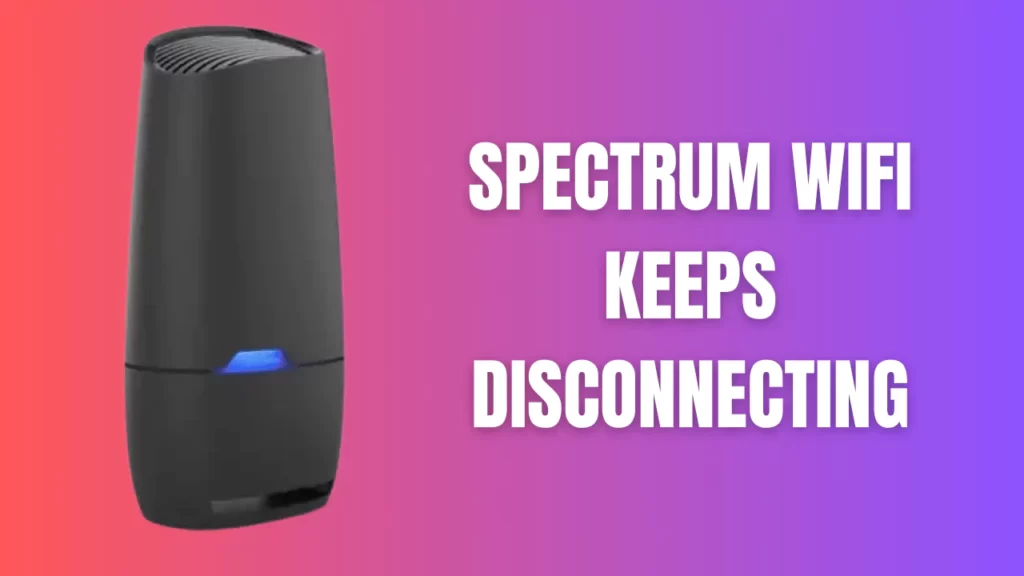If the Spectrum WiFi keeps disconnecting, then check whether there is an outage or any source of interference. You can also try to reboot the router or reposition it to get a suitable connection.
To reboot the router, you have to unplug the cables, keep it idle for 30 seconds, and then plug in the cables. Allow the router to boot, and then check the network speed.
Other than network issues, there are multiple reasons that can lead to Wi-Fi disconnecting errors, such as damaged cables, outdated firmware, too many devices connected to the Wi-Fi source, unstable network bandwidth, or a deactivated service pack.
You need long-term solutions to fix the Spectrum WiFi dropping issue, so let’s walk you through the quick and easy methods that you can apply in minutes.
How to fix your Spectrum WiFi that keeps disconnecting?
Malware can also lead to misconfiguration in the networking connection. So, before you proceed, use malware-detecting software and try to remove them. Next, follow the methods mentioned below to troubleshoot the Spectrum WiFi dropping issue.
Fix 1: Check for an outage
Network outages can occur at any time, and before you start with the other troubleshooting steps, use the Spectrum outage tool to detect whether there is any maintenance work being conducted or a malfunction in the server. You can also contact Spectrum customer service to get an estimated time when the connection will be restored.
Fix 2: Look for interference
If there are no outages, but you are still getting a poor signal, then it can be a result of too many walls between the device and the router. Even the presence of any large metal object can lead to Spectrum WiFi dropping issues.
So, start by checking whether the router is compatible with the device and then try to minimize the interference. Bring the router closer to the device you want to connect with. Also, if the router is placed at a higher position, then there might be a disturbance in distributing signal. So, either keep the router at a height where the signals are stable, or you can also install an antenna or Wi-Fi extender.
Fix 3: Get a Wi-Fi extender
There are many dead spots in your home where the network cannot reach. If you want to eliminate this error, then you need a Wi-Fi repeater or extender. Using this device, you can amplify the Wi-Fi signals transmitted to devices, and it will also eliminate the issue of dead spots.
Fix 4: Power cycle the router
If you have a router or a combination of router and modem, then based on the gateway system or standalone system, the power cycling steps vary. Here are the steps you need to follow:
If it is a standalone system, then unplug the cables from the power outlet, turn off the modem, and remove the battery. Wait for at least 60 seconds and then connect the modem and allow it to boot. Next, plug in the router, and after it starts working, check whether the problem has been resolved.
If it is a gateway system, then disconnect the router from the power outlet, wait for a minute or two, and then plug it into the power outlet. When the router reboots, verify the network connection
Fix 5: Look for damaged cable
Lose or damaged cables can also disrupt the network connection. So, verify them manually and, if required, replace them. In case of internal damage, it is hard to determine. So, try to use a spare cable to verify and replace the damaged cables. Always go with certified ones to avoid unnecessary network errors.
Fix 6: Reduce the number of devices connected to the network
If you have multiple devices connected to the same network at the same time, then it can create a congestive situation, leading to disruption in internet connection. So, to release the crowded networking situation, you have to disconnect a few of the devices or shut them down. Now, check whether the Wi-Fi speed is stable and strong. You can also use third-party applications to conduct speed tests to check the upload and download speed.
Fix 7: Switch to the Ethernet cable
You can also switch from Wi-Fi to Ethernet cable, which provides a more stable connection. Along with that, disable the Green Ethernet as it can affect the network performance. So, connect the device via ethernet cable, go to the Network and Sharing Centre of your Windows device, select Change Adapter Settings, and right-click on the Connection. Next, click on Properties, look for Configure, and select Advanced or Power Management. Now, you will find the Green Ethernet option; simply click on the Disable button.
Fix 8: Switch to a different network band
If your router has dual-band, then check and select the one that provides the most stable networking solution. Usually, dual-brand routers transmit 2.4 GHz or 5 GHz frequency, so to change them, log in and get to the Wireless Setting. Look for the channel menu and select any alternative frequency. Finally, click on Save or Apply and verify whether the change has improved your network connection
Fix 9: Check for firmware update
If you haven’t updated the firmware of the router for a long time, then get to settings and turn on the Auto-Update feature to avoid network interruption in the near future. Otherwise, you can also manually update the firmware using a computer.
Type the IP address “192.168.0.1” into the address bar, log in to your router admin panel using the correct credentials, and then check for firmware updates. If your specific model has an update available, then download and install it. Do not interrupt the process, and when the update is done, log out of your router admin panel. Restart the router and check whether the issue has been resolved.
Fix 10: Replace the router
If none of the above troubleshooting steps are able to enhance the speed or performance of the networking device, then the hardware might be faulty. You need to replace the Wi-Fi card or adapter to fix the problem.
How to keep the router in working condition?
The best possible way to keep the router running and performing well is to keep it clean, well-maintained, and free from dust. Check that it does not overheat, and you can use compressed air or cotton swabs to clean the stuck debris from the ports. You must also keep it away from direct sunlight and moisture to avoid damaging internal wiring.
How to set up a home network in the router?
You need to get a stable internet connection and then connect the computer to the router. Next, check whether the computer is able to access the internet connection, configure your router settings by accessing the router admin panel, and you are done setting up the home network.
What is the cost of Spectrum Internet?
The Spectrum Internet plans vary based on many factors, such as speed, connection type, location, length of contract, etc. The basic Spectrum Internet plan starts with a download speed of 60 Mbps and a 1-year contract, which is charged $30 per month.







